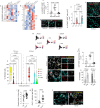Kupffer cell and recruited macrophage heterogeneity orchestrate granuloma maturation and hepatic immunity in visceral leishmaniasis
- PMID: 40169598
- PMCID: PMC11961706
- DOI: 10.1038/s41467-025-58360-x
Kupffer cell and recruited macrophage heterogeneity orchestrate granuloma maturation and hepatic immunity in visceral leishmaniasis
Abstract
In murine models of visceral leishmaniasis (VL), the parasitization of resident Kupffer cells (resKCs) drives early Leishmania infantum growth in the liver, leading to granuloma formation and subsequent parasite control. Using the chronic VL model, we demonstrate that polyclonal resKCs redistributed to form granulomas outside the sinusoids, creating an open sinusoidal niche that was gradually repopulated by monocyte-derived KCs (moKCs) acquiring a tissue specific, homeostatic profile. Early-stage granulomas predominantly consisted of CLEC4F+KCs. In contrast, late-stage granulomas led to remodeling of the sinusoidal network and contained monocyte-derived macrophages (momacs) along with KCs that downregulated CLEC4F, with both populations expressing iNOS and pro-inflammatory chemokines. During late-stage infection, parasites were largely confined to CLEC4F-KCs. Reduced monocyte recruitment and increased resKCs proliferation in infected Ccr2-/- mice impaired parasite control. These findings show that the ontogenic heterogeneity of granuloma macrophages is closely linked to granuloma maturation and the development of hepatic immunity in VL.
© 2025. This is a U.S. Government work and not under copyright protection in the US; foreign copyright protection may apply.
Conflict of interest statement
Competing interests: The authors declare no competing interests.
Figures






Update of
-
Kupffer cell and recruited macrophage heterogeneity orchestrate granuloma maturation and hepatic immunity in visceral leishmaniasis.bioRxiv [Preprint]. 2024 Jul 13:2024.07.09.602717. doi: 10.1101/2024.07.09.602717. bioRxiv. 2024. Update in: Nat Commun. 2025 Apr 01;16(1):3125. doi: 10.1038/s41467-025-58360-x. PMID: 39372777 Free PMC article. Updated. Preprint.
References
-
- Krenkel, O. & Tacke, F. Liver macrophages in tissue homeostasis and disease. Nat. Rev. Immunol.17, 306–321 (2017). - PubMed
-
- Guilliams, M. & Scott, C. L. Liver macrophages in health and disease. Immunity55, 1515–1529 (2022). - PubMed
-
- Sheng, J., Ruedl, C. & Karjalainen, K. Most tissue-resident macrophages except microglia are derived from fetal hematopoietic stem cells. Immunity43, 382–393 (2015). - PubMed
MeSH terms
Substances
LinkOut - more resources
Full Text Sources
Molecular Biology Databases
Miscellaneous

